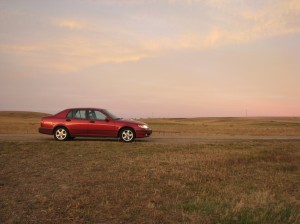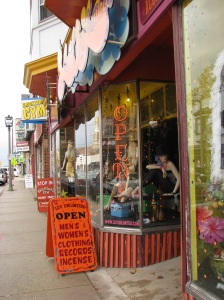I’m back home in Portland this week. My car is in Milwaukee. We’re both enjoying a welcome rest, after having just driven 2,560 miles over 13 days, completing the first leg of my (our?) cross-county journey. Here’s a town-by-town rendering of the trip, per Google Maps. More accurately, this is an around-the-country journey, and I’m undertaking it in segments – roughly 10 to 15 days of driving, followed by periods back home in Portland of the same length.
During my breaks at home, I’m leaving my car – a 1999 Saab 9.5 that had about 163,000 miles on it when I set off on October 9 – at various spots along the way. Now without a car in Portland, I’m getting around via public transportation, walking, and mooching rides off of friends – it’s fairly easy to function this way here, as I live in a condo downtown that overlooks a stop on the Streetcar line.
Portland and Milwaukee share certain a number of characteristics – similar population (both within city limits and metro), noted beer-brewing and manufacturing legacies, rivers crossed by multiple bridges, tightly defined neighborhoods, and rapid recent gentrification, to name a few. In fact, while eating dinner at the bar of Hinterland Gastropub on my one night in Milwaukee, upon mentioning that I was visiting from Portland, the bartender smiled knowingly and remarked, “ah, Portland, the Milwaukee of the Pacific.”
I see what he’s getting at, even though I’m ambivalent about comparing cities to each other. When writing about travel, it’s tempting to play destinations off of one another – I find it almost impossible not to do so. Partly, this is the language of travel – comparing places creates an easy descriptive shorthand. We perceive the new places we visit through a filter created by all those we’ve visited previously. Can I help it if I notice that Berlin – with its decentralized layout and abundance of arty, edgy neighborhoods – reminds me of Melbourne? Or if I think of an Iberian version of Provincetown whenever I’m in Sitges, Spain?
Well, it’s one thing to make a mental connection. It’s another to employ this approach excessively when writing about places. I think when I start painting in such broad strokes, and evaluating places in relation to others I’ve visited, I develop blind spots and biases. If I’ve quickly decided that Milwaukee is a Midwest version of Portland, I’m sure – at least unconsciously – I start seeking out evidence that will prove my hypothesis. And before I know it, I’ve created a vast West Coast versus Upper Midwest paradigm, where Minneapolis resembles Seattle, Chicago plays the role of San Francisco, and so on.
So, let’s go with this: I’ve been visiting Milwaukee every few years since the early ’90s, and it’s been good fun watching it morph from a pleasantly prosaic, blue-collar city with a propensity for mass-produced lager and Friday-night fish frys into a worldly metropolis with revitalized mixed-use neighborhoods and an imaginative, artisan-driven food and booze scene.
If you ask locals, by the way, for the impetus behind the city’s transformation over the past 15 years, they’ll often point to the increased cost of living in Chicago, 90 miles south. Many younger professionals, empty nesters, and artists priced out of Chicago have moved to more budget-friendly Milwaukee (driving up housing costs there, of course, as this trend always goes).
Even if you haven’t been to Milwaukee, you may be familiar with the architectural project that raised the city’s worldwide visibility exponentially: In 1994, the Milwaukee Art Museum hired renowned Valencian Spanish architect Santiago Calatrava to design a massive expansion. The angular, cantilevered structure – the first major Calatrava project completed in the United States – opened in 2001 and has become Milwaukee’s visual calling card. I love this building, which inspires comparisons of everything from the prow of a classic ocean liner to a giant snowy egret with its wings fully extended. The interior is no less dazzling – it’s like walking through Our Lady of Jane Jetson Cathedral.
The building’s sleek, horizontal countenance also looks perfect for the part of the country most associated with Frank Lloyd Wright – in fact, it wouldn’t be a stretch to see Calatrava’s concoction as a precocious stepchild of the Wright-designed (but only recently constructed) Monona Terrace Convention Center in Madison, Wisconsin.
I had lunch with a friend at Harbor House, a low-slung, gray-and-white clapboard building on the tip of a notch that juts into Lake Michigan and looks back across at the museum.

Who says you can't find a huge (and perfectly prepared) Maine-lobster roll in Milwaukee? Here's the Harbor House version...
It was a sunny fall day, and sitting there eating a huge lobster roll before a seemingly endless row of windows, squinting into the sun toward the steel louvers and cables that hold together Calatrava’s futuristic masterpiece, it was hard to remember my impressions of Milwaukee when I first visited in 1994.
I do recall dining at what seemed at the time like a super-trendy restaurant on downtown’s Cathedral Square, called Louise’s Trattoria – it’s well-liked to this day, and it still serves credibly good “designer pizzas” of the sort that were becoming wildly popular 15 years ago, thanks to the expansion of the California Pizza Kitchen brand. This was about when salads of goat cheese and sundried tomatoes, and thin-crust pizzas topped with barbecue chicken, were gaining credence among self-proclaimed foodies.
Beyond Louise’s and an also-still-exceptional “New American” restaurant called Sanford, Milwaukee was mostly about neighborhood taverns with neon beer signs, German bratwurst houses, heavy-handed steakhouses, and the like. Those types of hangouts have by no means disappeared, thankfully. But they’re joined now by an impressive mix of outstanding, chef-driven, farm-to-table restaurants – I mentioned a few more of these in a recent blog for About.com.
Milwaukee’s lakefront is beautiful – it overlooks that very same Lake Michigan that appears in countless photographs of Chicago. Here, though, especially in the neighborhoods on the East Side (which is just north of downtown, but so-named because it lies east of the Milwaukee River), the city rises along a bluff above the lake. The views are pretty incredible. Over the years, I’ve always found my way to Brady Street, which has been good for indie shopping, unfussy restaurants, and varying degrees of counterculture. Brady Street is still plenty of fun, but it’s now just a quirky little East Side strip in a city that abounds with newly invigorated, lively neighborhoods.
I walked along Brady Street after lunch, then got sidetracked driving to my hotel, the Iron Horse. It’s at the north tip of Walker’s Point (also sometimes called the Fifth Ward), a formerly obscure (to visitors, at least) warren of hulking industrial buildings, endearingly dive-y gay bars, and very good Mexican restaurants. And this is where I found myself turning down side streets and driving onto abandoned factory lots, taking pictures and thinking a lot of Portland (perhaps, in part, because I was scheduled to fly home the following day).
Walker’s Point and the adjacent Menomonee River Valley look more than a little like Portland’s Pearl District – disused industrial buildings metamorphosed into chic lofts, condos, restaurants, and studios.
The swanky Iron Horse Hotel opened in 2009 inside a century-old, six-story redbrick warehouse that once contained a bedding factory, then a cold-storage facility. It’s adjacent to a still-active freight rail line, and the developers incorporated the building’s atmospheric old bones – hemlock beams, heart pine floors, cream-brick walls (did you know Milwaukee’s nickname “Cream City” derives from its many cream-color brick buildings?), and tall windows – into the design.
From here, in the evening, I walked to Hinterland Gastropub by strolling across the Milwaukee River into the Historic Third Ward, once the city’s Italian district and now the most lively of Milwaukee’s dining and nightlife quarters (and also home to the exceptional Milwaukee Public Market).
At Hinterland, I sat at the bar and bantered happily about wine with this bartender, Dan, who very clearly loves what he’s doing and delighted in introducing me to a slew comparatively unusual wines (i.e., Beaulieu Picpoul de Pinet, a downright obscure and perfectly crisp white varietal from Languedoc, along with better-known Berger Gruner Veltliner from Austria, and one of my favorite Italian red bargains, Cusamano Nero d’Avola). I drank too much, in the process of chatting endlessly about food with various Hinterland staffers, including another Dan, chef Dan Van Rite (who trained in, of course, Portland). After eating a salad comprising greens and beets from a small, family-operated local farm called Buddha Baby, and moving along to duck-liver terrine with onion preserves, and house-made-chorizo tacos with cabbage slaw and sriracha sauce, I was ready to call this one of the best meals I’ve eaten over the past year.

Can you believe they banned foie gras in Chicago for a while? Here's the foie gras torchon at Hinterland
Then, as if to ensure I’ll end up suffering someday from gout, chef Dan sent out a plate of Foie gras torchon (a process by which the lobe of foie gras is poached – here’s a very graphic explanation of how you make it) with hazelnuts, dried cherries, and black-pepper gastrique.
As rich as my dinner may have been, I didn’t even end up with a headache the next morning. I walked across a different bridge (over the Menomonee River) for a quick look around the gargantuan Harley-Davidson Museum, which opened in 2008.
Then I made the best use I could of my remaining couple of hours in town, driving north then west then ultimately south to explore yet a few more of Milwaukee’s more interesting neighborhoods. I ended up in another facet of the city’s remarkable renaissance, Bay View, which had been a fairly nondescript residential neighborhood – developed in 1879 as the city’s first real suburb – before receiving a heady shot of gentrification beginning around the late ’90s.
These days along the main drag, the jaunty-sounding Kinnickinnic Avenue (named for yet another river that flows through downtown Milwaukee), you can’t walk 50 feet without passing some establishment that carries either Blatz Beer on tap or fair-trade organic coffee.
I could just as easily have been walking along Alberta Street or Hawthorne Boulevard on Portland’s East Side.
It was 1:50 on the first rainy day I’d experienced the entire trip. My flight back to Portland, by way of Las Vegas, was scheduled to depart at 3:30. I walked out of Bay View’s bohemian Sven’s Cafe with a latte and a cookie smothered in pretzel bits, chocolate chips, and at least three or four other happily junky toppings, and Googled “cheap milwaukee airport parking” on my phone. Within 40 minutes, my car parked securely at an $8/day discount lot, I strolled through security at Milwaukee’s wonderfully attractive, manageable, and efficient airport.
“This is a lot like Portland’s airport,” I thought.









Hey, really great blog post… I’ve enjoyed reading through your blog because of the great style and energy.
I actually work for the CheapOair travel blog. If you’re interested, we would love to have you on as a guest blogger. Please send me an e-mail: gchristodoulou(at)cheapoair(dot)com, and I can give you more information. Looking forward to hearing from you.
lol interesting. very detailed. i’ve never been to Milwaukee…….
does it rain 10 months out of the year there too?
George – thanks very much! I will e-mail as soon as I have the chance (crazy week right now traveling), but assuming I can find sometime I’d be very interested…
Michael – ha…well, in Portland we deal with the winter rain, and in Milwaukee they deal with the lake-effect snow. Fortunately, there’s good food in both places to comfort chilled souls…
You forgot to mention the parks.
Boerner gardens.
Mitchel park conservatory.
Bucks.
Brewers.
Packers.
Symphony,.
Repertory theatre.
Pabst theatre.
Riverside theatre.
Miller Park.
Golf.
Cao Jai, Krup?
You get no argument from me – all additionally great aspects of life in Milwaukee…